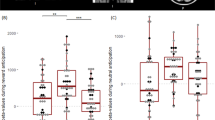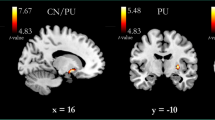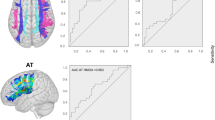Abstract
Rationale
Dysfunctional reward processing has been proposed as a main deficit in attention-deficit/hyperactivity disorder (ADHD), which could be modulated by treatment with methylphenidate (MPH).
Objectives
We examined differences in reward processing in adulthood (independent of actual ADHD) depending on MPH treatment during childhood.
Methods
Eleven males with childhood ADHD treated with MPH, 12 drug-naïve males with childhood ADHD, and 12 controls matched by age, handedness, and smoking behavior were studied drug-free using functional magnetic resonance imaging. BOLD-responses were compared during a monetary incentive delay task using an ANOVA design focusing on the ventral striatum during anticipation and the orbitofrontal cortex during outcome.
Results
Controls, drug-naïve, and treated subjects did not differ significantly in their activations in the ventral striatum and orbitofrontal cortex. Explorative analyses revealed decreased insula activation during outcome of loss avoidance in drug-naïve subjects in comparison to both groups, while treated subjects did not differ from controls. Insula activation correlated significantly positive with harm avoidance in the treated group. Furthermore, comparing subjects with actual ADHD symptoms, remitters and controls we observed decreased putamen activition in ADHD persisters.
Conclusions
Basal ganglia reward processing seemed to be unrelated to MPH pretreatment, but was related to remission. On the other hand, the revealed differences between treated and drug-naïve subjects with childhood ADHD, i.e., in the insula, give evidence for more pronounced abnormal activation in reward-associated brain regions in untreated subjects with childhood ADHD and underpin the need of prospective studies on long-term effects of psychostimulant treatment.


Similar content being viewed by others
References
Biederman J, Monuteaux MC, Spencer T, Wilens TE, Macpherson HA, Faraone SV (2008) Stimulant therapy and risk for subsequent substance use disorders in male adults with ADHD: a naturalistic controlled 10-year follow-up study. Am J Psychiatry 165:597–603
Bledsoe J, Semrud-Clikeman M, Pliszka SR (2009) A magnetic resonance imaging study of the cerebellar vermis in chronically treated and treatment-naïve children with attention-deficit/hyperactivity disorder combined type. Biol Psychiatry 65(7):620–624
Bush G, Spencer TJ, Holmes J, Shin LM, Valera EM, Seidman LJ, Makris N, Surman C, Aleardi M, Mick E, Biederman J (2008) Functional magnetic resonance imaging of methylphenidate and placebo in attention-deficit/hyperactivity disorder during the multi-source interference task. Arch Gen Psychiatry 65:102–114
Cardinal RN, Pennicott DR, Sugathapala CL, Robbins TW, Everitt BJ (2001) Impulsive Choice induced in rats by lesions of the nucleus accumbens core. Science 292:2499–2501
Carmona S, Proal E, Hoekzema EA, Gispert JD, Picado M, Moreno I, Soliva JC, Bielsa A, Rovira M, Hilferty J, Bulbena A, Casas M, Tobeña A, Vilarroya O (2009) Ventro-striatal reductions underpin symptoms of hyperactivity and impulsivity in attention-deficit/hyperactivity disorder. Biol Psychiatry 66(10):972–977
Castellanos FX, Lee PP, Sharp W, Jeffries NO, Greenstein DK, Clasen LS, Blumenthal JD, James RS, Ebens CL, Walter JM, Zijdenbos A, Evans AC, Giedd JN, Rapoport JL (2002) Developmental trajectories of brain volume abnormalities in children and adolescents with attention-deficit/hyperactivity disorder. JAMA 288(14):1740–1748
Cloninger CR (1999) The temperament and Character Inventory-Revised. Washington University, St. Louis, MO, Center for Psychobiology of Personality
Connors CR, Erhardt D, Sparrow E (1999) Connors‘Adult Rating Scales (CAARS). Multi-Health Systems, Nort, Tonawada
Craig AD (2009) How do you feel-now? The anterior insula and human awareness. Nat Rev Neurosci 10:59–70
Cubillo A, Rubia K (2010) Structural and functional brain imaging in adult attention-deficit/hyperactivity disorder. Expert Rev Neurother 10(4):603–620
Cubillo A, Halari R, Ecker C, Giampietro V, Taylor E, Rubia K (2010) Reduced activation and inter-regional functional connectivity of fronto-striatal networks in adults with childhood Attention-Deficit Hyperactivity Disorder (ADHD) and persisting symptoms during tasks of motor inhibition and cognitive switching. J Psychiatr Res, Epub
Daw ND, O'Doherty JP, Dayan P, Seymour B, Dolan RJ (2006) Cortical substrates for exploratory decisions in humans. Nature 441:876–879
De Martino B, Kumaran D, Holt B, Dolan RJ (2009) The neurobiology of reference-dependent value computation. J Neurosci 29:3833–3842
Dodds CM, Müller U, Clark L, van Loon A, Cools R, Robbins TW (2008) Methylphenidate has differential effects on blood oxygenation level-dependent signal related to cognitive subprocesses of reversal learning. J Neurosci 28:5976–5982
Elliott R, Friston KJ, Dolan RJ (2000) Dissociable neural responses in human reward systems. J Neurosci 20:6159–6165
Ernst M, Kimes AS, London ED, Matochik JA, Eldreth D, Tata S (2003) Neural substrates of decision Making in adults with attention deficit hyperactivity disorder. Am J Psychiatry 160:1061–1070
Faraone SV, Wilens T (2003) Does stimulant treatment lead to substance use disorders? J Clin Psychiatry 64(Suppl 11):9–13
First MB, Spitzer RL, Gibbon M, Williams J (2001) Structured Clinical Interview for DSM-IV-TR axis I disorders, research version, patient edition with Psychotic Screen (SCID-I/P W/PSY SCREEN). New York State Psychiatric Institute, New York
Goksoyr PK, Nøttestad JA (2008) The burden of untreated ADHD among adults: the role of stimulant medication. Addict Behav 33:342–346
Goodman R, Simonoff E, Stevenson J (1995) The impact of child IQ, parent IQ and sibling IQ on child behavioural deviance scores. J Child Psychol Psychiatry 36(3):409–425
Henriquez-Henriquez M, Zamorano-Mendieta F, Rothhammer-Engel F, Aboitiz F (2010) Neurocognitive models for attention deficit hyperactivity disorder and their consequences on the searching of endophenotypes. Rev Neurol 50:109–116
Huettel SA, Stowe CJ, Gordon EM, Warner BT, Platt ML (2006) Neural signatures of economic preferences for risk and ambiguity. Neuron 49:765–775
Huss M, Poustka F, Lehmkuhl G, Lehmkuhl U (2008) No increase in long-term risk for nicotine use disorders after treatment with methylphenidate in children with attention-deficit/hyperactivity disorder (ADHD): evidence from a non-randomised retrospective study. J Neural Transm 115:335–339
Knutson B, Adams CM, Fong GW, Hommer D (2001a) Anticipation of increasing monetary reward selectively recruits nucleus accumbens. J Neurosci 21:RC159
Knutson B, Fong GW, Adams CM, Varner JL, Hommer D (2001b) Dissociation of reward anticipation and outcome with event-related fMRI. NeuroReport 12:3683–3687
Knutson B, Taylor J, Kaufman M, Peterson R, Glover G (2005) Distributed neural representation of expected value. J Neurosci 25:4806–4812
Kobel M, Bechtel N, Weber P, Specht K, Klarhöfer M, Scheffler K, Opwis K, Penner I-K (2009) Effects of methylphenidate on working memory functioning in children with attention deficit/hyperactivity disorder. Eur J Pediatr Neurol 13:516–523
Konrad K, Neufang S, Fink MA, Fink R, Herpertz-Dahlmann B (2007) Long-term effects of methylphenidate on neural networks associated with executive attention in children with ADHD: Results from a longitudinal functional MRI study. J Am Acad Child Adolesc Psychiatry 46:1633–1641
Krain AL, Castellanos FX (2006) Brain development and ADHD. Clin Psychol Rev 26:433–444
Kuhnen CM, Knutson B (2005) The neural basis of financial risk taking. Neuron 47:763–770
Ludolph AG, Kassubek J, Schmeck K, Glaser C, Wunderlich A, Buck AK, Reske SN, Fegert JM, Mottaghy FM (2008) Dopaminergic dysfunction in attention deficit hyperactivity disorder (ADHD), differences between pharmacologically treated and never treated young adults: A 3, 4-dihydroxy-6-[18 F]fluorophenyl-L-alanine PET study. Neuroimage 41:718–727
Luman M, Van Meel CS, Oosterlaan J, Sergeant JA, Geurts HM (2009) Does reward frequency or magnitude drive reinforcement-learning in attention-deficit/hyperactivity disorder? Psychiatry Res 168:222–229
Manuzza S, Klein RG, Truong NL, Moulton JL 3rd, Roizen ER, Howell KH, Castellanos FX (2008) Age of methylphenidate treatment initiation in children with ADHD and later substance abuse: prospective follow-up into adulthood. Am J Psychiatry 165:604–609
Mason MF, Norton MI, Van Horn JD, Wegner DM, Grafton ST, Macrae CN (2007) Wandering minds: the default network and stimulus-independent thought. Science 315:393–395
Oldfield RC (1971) Assessment and analysis of Handeness-Edinburgh Inventory. Neuropsychologia 9:97–104
Paulus MP, Rogalsky C, Simmons A, Feinstein JS, Stein MB (2003) Increased activation in the right insula during risk-taking decision making is related to harm avoidance and neuroticism. Neuroimage 19:1439–1448
Peterson BS, Potenza MN, Wang Z, Zhu H, Martin A, Marsh R, Plessen KJ, Yu S (2009) An fMRI study of the effects of psychostimulants on default-mode processing during stroop task performance in youths with ADHD. Am J Psychiatry 166:1286–1294
Plichta MM, Vasic N, Wolf RC, Lesch K-P, Brummer D, Jacob C, Fallgater JA, Grön G (2009) Neural hyporesponsiveness and hyperresponsiveness during immediate and delayed reward processing in adult attention-deficit/hyperactivity disorder. Biol Psychiatry 65:7–14
Pliszka SR, Glahn DC, Semrud-Clikeman M, Franklin C, Perez R 3rd, Xiong J, Liotti M (2006) Neuroimaging of inhibitory control areas in children with attention deficit hyperactivity disorder who were treatment naive or in long-term treatment. Am J Psychiatry 163(6):1052–1060
Preuschoff K, Quartz SR, Bossaerts P (2008) Human insula activation reflects risk prediction errors as well as risk. J Neurosci 28:2745–2752
Rosa Neto P, Lou H, Cumming P, Pryds O, Gjedde A (2002) Methylphenidate-evoked potentiation of extracellular dopamine in the brain of adolescents with premature birth: correlation with attentional deficit. Ann NY Acad Sci 965:434–439
Robbins TW (1978) The acquisition of responding with conditioned reinforcement: effects of pipradrol, methylphenidate, d-amphetamine, and nomifensine. Psychopharmacol Berl 58:79–87
Rubia K, Smith AB, Halari R, Matsukura F, Mohammad M, Taylor E, Brammer MJ (2009a) Disorder-specific dissociation of orbitofrontal dysfunction in boys with pure conduct disorder during reward and ventrolateral prefrontal dysfunction in boys with pure ADHD during sustained attention. Am J Psychiatry 166(1):83–94
Rubia K, Halari R, Cubillo A, Mohammad AM, Brammer M, Taylor E (2009b) Methylphenidate normalises activation and functional connectivity deficits in attention and motivation networks in medication-naïve children with ADHD during a rewarded continuous performance task. Neuropharmacology 57:640–652
Rubia K, Halari R, Christakou A, Taylor E (2009c) Impulsiveness as a timing disturbance: neurocognitive abnormalities in attention-deficit hyperactivity disorder during temporal processes and normalization with methylphenidate. Philos Trans R Soc Lond B Biol Sci 364(1525):1919–1931
Sagvolden T, Johansen EB, Aase H, Russell VA (2005) A dynamic developmental theory of attention-deficit/hyperactivity disorder (ADHD) predominantly hyperactive/impulsive and combined subtypes. Behav Brain Sci 28:397–468
Sanfey AG, Rilling JK, Aronson JA, Nystrom LE, Cohen JD (2003) The neural basis of economic decision-making in the Ultimatum Game. Science 300:1755–1758
Sarinopoulos I, Gruppe DW, Mackiewicz KL, Herrington JD, Lor M, Steege EE, Nitschke JB (2009) Uncertainty during Anticipation Modulates Neural Responses to Aversion in Human Insula and Amygdala. Cereb Cortex, Epub
Scheres A, Milham MP, Knutson B, Castellanos FX (2007) Ventral striatal hyporesponsiveness during reward anticipation in attention-deficit/hyperactivity disorder. Biol Psychiatry 61:720–724
Schlochtermeier L, Stoy M, Schlagenhauf F, Wrase J, Park SQ, Friedel E, Huss M, Lehmkul U, Heinz A, Ströhle A (2010) Childhood methylphenidate treatment of ADHD and response to affective stimuli. Eur Neuropsychopharmacol. doi:10.1016/j.euroneuro.2010.05.001
Schmack K, Schlagenhauf F, Sterzer P, Wrase J, Beck A, Dembler T, Kalus P, Puls I, Sander T, Heinz A, Gallinat J (2008) Catechol-O-methyltransferase val(158)met genotype influences neural processing of reward anticipation. Neuroimage 42:1631–1638
Schmidt K, Metzler P (1992) Wortschatztest WST. Weinheim, Beltz Test
Schweitzer JB, Lee DO, Hanford RB, Zink CF, Ely TD, Tagamets MA, Hoffman JM, Grafton ST, Kilts CD (2004) Effect of methylphenidate on executive functioning in adults with attention-deficit/hyperactivity disorder: normalization of behavior but not related brain activity. Biol Psychiatry 56:597–606
Semrud-Clikeman M, Pliśzka SR, Lancaster J, Liotti M (2006) Volumetric MRI differences in treatment-naïve vs chronically treated children with ADHD. Neurology 26;67(6):1023–1027
Shafritz KM, Marchione KE, Gore JC, Shaywitz SE, Shaywitz BA (2004) The effects of methylphenidate on neural systems of attention in attention deficit hyperactivity disorder. Am J Psychiatry 161(11):1990–1997
Shaw P, Sharp WS, Morrison M, Eckstrand K, Greenstein DK, Clasen LS, Evans AC, Rapoport JL (2009) Psychostimulant treatment and the developing cortex in attention deficit hyperactivity disorder. Am J Psychiatry 66(1):58–63
Sobel LJ, Bansal R, Maia TV, Sanchez J, Mazzone L, Durkin K, Liu J, Hao X, Ivanov I, Miller A, Greenhill LL, Peterson BS (2010) Basal ganglia surface morphology and the effects of stimulant medications in youth with attention deficit hyperactivity disorder. Am J Psychiatry 167(8):977–986
Sonuga-Barke EJ (2003) The dual pathway model of AD/HD: an elaboration of neuro-developmental characteristics. Neurosci Biobehav Rev 27:593–604
Stein MB, Simmons AN, Feinstein JS, Paulus MP (2007) Increased amygdala and insula activation during emotion processing in anxiety-prone subjects. Am J Psychiatry 164:318–327
Ströhle A, Stoy M, Wrase J, Schwarzer S, Schlagenhauf F, Huss M, Hein J, Nedderhut A, Neumann B, Gregor A, Juckel G, Knutson B, Lehmkuhl U, Bauer M, Heinz A (2008) Reward anticipation and outcomes in adult males with attention-deficit/hyperactivity disorder. Neuroimage 39:966–972
Vaidya CJ, Austin G, Kirkorian G, Ridlehuber HW, Desmond JE, Glover GH (1998) Selective effects of methylphenidate in attention hyperactivity disorder: A functional magnetic resonance study. Proc Natl Acad Sci USA 95:14494–14499
Volkow ND, Wang GJ, Fowler JS, Gatley SJ, Logan J, Ding YS, Hitzemann R, Pappas N (1998) Dopamine transporter occupancies in the human brain induced by therapeutic doses of oral methylphenidate. Am J Psychiatry 155:1325–1331
Volkow ND, Fowler JS, Wang G, Ding Y, Gatley SJ (2002) Mechanism of action of methylphenidate: insights from PET imaging studies. J Atten Disord 6(Suppl 1):S31–S43
Volkow ND, Wang GJ, Kollins SH, Wigal TL, Newcorn JH, Telang F, Fowler JS, Zhu W, Logan J, Ma Y, Pradhan K, Wong C, Swanson JM (2009) Evaluating dopamine reward pathway in ADHD: clinical implications. JAMA 302:1084–1091
Wächter T, Lungu OV, Liu T, Willingham DT, Ashe J (2009) Differential effect of reward and punishment on procedural learning. J Neurosci 29:436–443
Wade TR, de Wit H, Richards JB (2000) Effects of dopaminergic drugs on delayed reward as a measure of impulsive behavior in rats. Psychopharmacol Berl 150:90–101
Ward MF, Wender PH, Reimherr FW (1993) The Wender Utah Rating Scale: an aid in the retrospective diagnosis of childhood attention deficit hyperactivity disorder. Am J Psychiatry 150:885–890
Wittchen HU, Pfister H (1997) DIA-X-Interviews:PC Programm zur Durchführung des Interviews; Auswertungsprogramm Frankfurt: Swets und Zeitlinger
Wrase J, Kahnt T, Schlagenhauf F, Beck A, Cohen MX (2007a) Different neural systems adjust motor behavior in response to reward and punishment. Neuroimage 36:1253–1262
Wrase J, Schlagenhauf F, Kienast T, Wüstenberg T, Bermpohl F, Kahnt T, Beck A, Ströhle A, Juckel G, Knutson B, Heinz A (2007b) Dysfunction of reward processing correlates with alcohol craving in detoxified alcoholics. Neuroimage 35:787–794
Acknowledgments
Author contributions
A. Ströhle had full access to all the data in the study and takes responsibility for the integrity of the data and the accuracy of the data analysis.
Additional contributions
We thank the participants for their patience and willingness to participate after many years and followed through with an extensive neuropsychological testing and fMRI-scanning. We thank the colleagues of the laboratory of emotional neuroscience for the assistance with the fMRI-scanning.
Conflicts of interest
None
Funding/support
None
Financial disclosures
Prof. A. Ströhle received research funding from the German Federal Ministry of Education and Research and speaker honoraria from Pfizer, Eli Lilly & Co, Wyeth, Lundbeck and a research grant from Lundbeck. Prof. A. Heinz received research funding from the German Research Foundation and the Bernstein Center for Computational Neuroscience Berlin (German Federal Ministry of Education and Research), Eli Lilly & Company, Janssen-Cilag, and Bristol-Myers Squibb. A. Heinz also received speaker Honoraria from Janssen-Cilag, Johnson & Johnson, Lilly, Pfizer and Servier. Prof. U. Lehmkuhl received research funding from the Deutsche Krebshilfe Research Foundation; the BfArM (Bundesinstitut für Arzneimittelforschung und Medizinprodukte); RTL Foundation “Wir helfen Kindern”; BMFSFJ Research Funding from the German Federal Ministry of Health; Steiner Arzneimittel. Mrs. Stoy, Mrs. Schlochtermeier, Dr. Schlagenhauf, Dr. Wrase, Prof. Huss, Prof. Knutson reported no conflicts of interest.
Ethical standards
This study complies with the current laws of Germany.
Author information
Authors and Affiliations
Corresponding author
Electronic supplementary material
Below is the link to the electronic supplementary material.
ESM 1
(DOC 36 kb)

Figure S1
Plot of reaction times of the three groups (controls, childhood ADHD-drug-naïve, and childhood ADHD-MPH) in the seven conditions (loss, −3 to −0.10 €, neutral, gain, +0.10 to 3 €) (JPEG 195 kb)

Figure S2
Plot of subjective effort of the three groups (controls, childhood ADHD-drug-naïve, and childhood ADHD-MPH) in the seven conditions (loss, −3 to −0.10 €, neutral, gain, +0.10 to 3 €) (JPEG 174 kb)
Figure S3
Anticipation of gain (controls/childhood ADHD-drug-naïve/-MPH). Effect of group in the left inferior frontal gyrus (BA 45) for the contrast ‘anticipation of gain > anticipation of neutral’ with the parameter estimates (Tal: −50, 35, 4; F = 10.16). b Effect of group in the right inferior frontal gyrus (BA 46) for the contrast ‘anticipation of gain > anticipation of neutral’ with the parameter estimates (Tal: 42, 38, 4; F = 11.60) (PPT 968 kb)
Table S1
ANOVA (controls/childhood ADHD-drug-naïve/-MPH) (DOC 75 kb)
Table S2
Within-group activations (controls/childhood ADHD-drug-naïve/-MPH) (DOC 47.0 kb)
Table S3
Remitters vs. persisters: behavioural, neuropsychological data and personality (DOC 40.5 kb)
Table S4
Remitters vs. persisters: group characteristics and clinical data (DOC 44 kb)
Table S5
ANOVA (controls/ADHD-remitted/-non-remitted) (DOC 60 kb)
Rights and permissions
About this article
Cite this article
Stoy, M., Schlagenhauf, F., Schlochtermeier, L. et al. Reward processing in male adults with childhood ADHD—a comparison between drug-naïve and methylphenidate-treated subjects. Psychopharmacology 215, 467–481 (2011). https://doi.org/10.1007/s00213-011-2166-y
Received:
Accepted:
Published:
Issue Date:
DOI: https://doi.org/10.1007/s00213-011-2166-y




